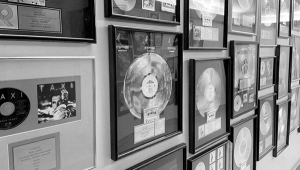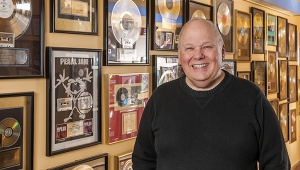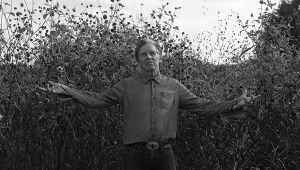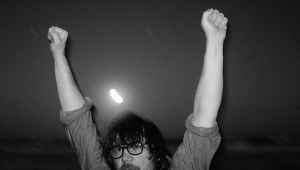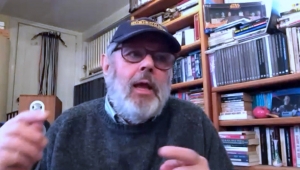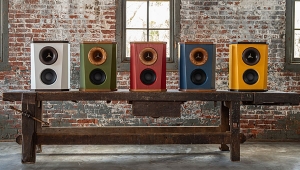| Columns Retired Columns & Blogs |
David Wilson: Speaking the Same Language
Wes Phillips: How did you come to design the WATT—and the Puppy?
David Wilson: I began making serious recordings back in the late '70s, and monitored them on a variety of commercially available speakers. By about 1980 I had developed the first generation of the WAMM system, on which I would listen to the recordings critically. Generally, what I heard in the field on the monitor speakers and what I heard from the WAMMs was in agreement—the WAMMs told us a lot more, of course, but if a recording sounded okay on the monitors, then it would sound pretty good on the WAMMs.
For some time my wife and partner Sheryl had been asking me to design a smaller system, one that was more affordable and that we could sell in reasonable numbers, but I, from the standpoint of the great artist [heh-heh], couldn't see it. Then, in 1985, we recorded in a very difficult hall—I had brought two different monitor speakers and they told me very different stories about what was going into the microphones and onto the tape. Neither set was telling me a very accurate story, so that when I brought the tapes home and played them on the WAMM, what I heard was totally unacceptable. It was as though the speakers were all speaking different languages. At that point I realized that, unless I developed a speaker that spoke the same language as the WAMM, I was likely to put myself in precarious situations like this in the future.
Sheryl said, "I told you so!"
I had to establish the architecture of the system before I could progress on the design. By that I mean that I had to determine exactly what the user requirement for the system was—and that took quite a while. When I decided upon the basic configuration, the next step was to examine the performance levels that can be achieved.
Through an iterative process you determine whether the architecture and the performance level are functioning to a satisfactory degree. In the WATT, my primary performance demand was resolving ability. Both of the monitors I had used at my disastrous sessions were speakers that most people would find musically acceptable for listening to prerecorded material, because they would tend to hide certain flaws—which was the opposite of what I needed. I required a speaker with low levels of coloration and rapid settling times as measured on the cumulative spectral-decay test.
Next I needed a speaker that excelled at resolving dynamic shading, which is one of the areas where musicians express themselves artistically. Often you'll have two takes which are very similar to one another, perhaps even containing the same number of mistakes, but the musician will prefer one to the other from an interpretive standpoint.
My last requirement concerned soundstaging—which tells the story about your microphone placement. You have to make these decisions quickly.
Most people would add low-bass extension to this list, but I had decided that, with the architecture I had chosen, it was impossible to have large quantities of high-quality low bass. I remembered my experiences with the Quad electrostatics and realized that if the harmonic structure of the loudspeaker was true, you could surmise the performance of the recording in the low frequencies.
After having determined what the architecture was, and that the performance criteria were not at variance with it, we began the process of refining the design. During this stage, Sheryl and I took a one-week vacation to Mazatlán and I sort of mulled over my ideas while we were on the beach. One day, we heard a band playing and went over to listen to them; I looked at the back of their PA system and saw that all of the connections were so corroded that they looked more like green crystals than any form of metal! That's when I decided that the speaker would have stainless-steel hardware, so that it would hold up in humid environments. I wasn't really planning on selling very many of these—I knew they'd be very expensive. I wanted them primarily for my personal use.
Phillips: Did it surprise you when they proved to be popular?
Wilson: Well, it did. In 1986, the most expensive minispeaker in the US was the Celestion SL-600, which sold for about $1600/pair. We introduced the WATT at $4400/pair. Actually, when we first showed the WATT at the 1986 WCES, we had no idea of offering it as a commercial product; we were promoting our recordings and we used the speaker to promote Mickey Hart's Rhythm Devils recording of music from Apocalypse Now. We had the speakers out in the center of the room—and a WAMM subwoofer tucked away in the corner—and on a couple of tracks that woofer would really dish it out, which brought people into the room. A lot of them would stay and listen to other music, and then they wanted the speaker! So I had to decide whether to offer it as a product. Finally we did.
Phillips: When you decided to offer it to the public, did you rethink any of your design goals to accommodate the change in end-user?
Wilson: No, it stayed very pure. I've found that, as a designer, it's important that my products express my design. I'm not market-driven, per se. I design products that I enjoy, and there are always going to be some people out there who enjoy some of the same things that I enjoy in a loudspeaker—those people constitute our market. So the WATT Series I was exactly the same as the prototype we showed in Las Vegas.
Frankly, I was surprised at the market acceptance; here was a speaker that was extremely expensive for its size and had no low-bass extension, but many people—particularly those who listened to acoustic jazz and chamber music—really appreciated the resolution and transparency of the system, which were at unprecedented levels.
Phillips: You immediately began to devise solutions to the bass-extension problem. I remember that you offered a "beard" almost immediately after the WATT's launch.
Wilson: That was a suggestion IAR's J. Peter Moncrieff made when he heard them at the '86 WCES. We experimented with various sizes before coming up with one that provided about an additional half-octave of 2pi steradian support—which helped add some warmth.
A lot of people were buying subwoofers to supplement the WATT's sound, but even the best didn't really keep up with the WATT's speed—they did, however, add some needed low-end extension. We learned a lot of lessons from using these other subs, including how "fast" a subwoofer needed to be, and we had a basic architecture manifested by the height and width dictated by the WATTs. We also analyzed the bass-extension requirements of sensitive listeners and concluded that, if we could produce clean, fast sound down to 40Hz, it would be sufficient—which is also what Gilbert A. Briggs of Wharfedale Wireless Works had determined back in 1955!
I knew that I couldn't get extension much below 35Hz and still retain the lightning-fast transient response that blending a woofer with the WATTs required. We also needed high power-handling capacity (for reliability), speed, and efficiency—all of which dictated the use of multiple 8" drivers with massive motor structures.
We ended up getting more than we bargained for in bass extension—Martin Colloms has measured 27Hz in his room, but we just tell people that it will do 30Hz; the 40Hz figure was just to keep me honest.
- Log in or register to post comments

